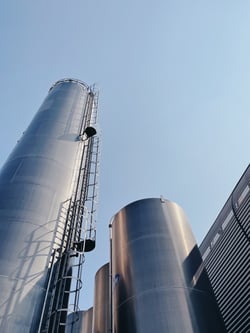 "Grain bin fires rarely occur, but they can happen when conditions include high humidity and wet grain, and farmers try to rush the dryer. Fires can be caused by poor housekeeping of the bins, failure to clean beneath floors, poorly maintained burners and other equipment, and operating the burners at too high a temperature in an attempt to dry grain faster.” -Herb Wilcutt, Safety Specialist, Mississippi State University Extension Service
"Grain bin fires rarely occur, but they can happen when conditions include high humidity and wet grain, and farmers try to rush the dryer. Fires can be caused by poor housekeeping of the bins, failure to clean beneath floors, poorly maintained burners and other equipment, and operating the burners at too high a temperature in an attempt to dry grain faster.” -Herb Wilcutt, Safety Specialist, Mississippi State University Extension Service
Grain bin and crop storage fires may not be an everyday occurrence, but there are definitely examples of bin fires and grain dryer fires happening—especially, oddly enough, during a wet or late harvest season.
While it may at first seem counterintuitive to increase fire prevention and other safety measures during a rainy harvest season, feed grain producers are forced to dry their harvest during processing and before storage if the temperatures or moisture levels are too high, which is when the risk of fires and other dangers can increase.
How can those in the agricultural industry maintain the safest possible conditions?
The Causes of Dust Explosions and Fires
What leads to a grain dust explosion? Oklahoma State University Extension reports that several basic elements must be present for conditions to be ripe for explosion:
- Fuel: Something has to be there to fuel the fire. In the case of grain bins, this takes the form of small, dry grain dust particles like those in wheat, oats, barley, oat flour, or cornstarch. This dust only needs to be suspended in the air to create an explosion.
- Oxygen: Plenty of air supply to combust with the fuel, which can happen at normal oxygen levels.
- Confinement: Vertical elevator leg casings and housings, enclosed drag conveyors, dust bins, downspouts, an aeration duct, a basement tunnel, bin deck galleries, bins, and silos are all prime, and confined locations for explosions to occur.
- Ignition source: An overheated bearing in an elevator, elevator leg belts rubbing against sidewall casings, electrical arcs from non-explosion-proof electrical devices, and even a quick electrical short can all cause an explosion. Wet aeration ducts and even a lit cigarette or metal sparks from a grinder, a dropped tool, or even lightning can also all act as ignition sources.
Additionally, it’s important to note that in low relative humidity and moisture conditions, static electricity can build up and serve as an ignition source when grain is overly dry.
Feed Navigator also cites high temperatures (like those that occur when grains are drying or processing, or if grains are allowed to overheat in the storage bin) can contribute to explosions and fires.
Moisture as a Cause for Fire
Another cause of fires in the processing and storage of crops? Believe it or not, too much moisture can be a direct cause of a fire. How can that be? Take hay crops for example. According to the South Dakota State University Extension, excessive moisture in the plant (in this case, anything above 20 percent) results in heating when the hay is baled or stacked for long-term storage.
Why is this? The hay plant tissue dries down in a normal process known as “sweating” or “heating,” until plant material decreases to a level below 15 percent. However, when hay is harvested at moisture levels higher than 20 percent, it can cause existing bacteria to grow rapidly, encouraged by the excess moisture present, which produces heat in the bale.
The temperature at the bale’s core will climb higher and higher as it goes through cycles of heating and drying. In the case of hay bales, spontaneous combustion can occur when interior bale temperatures reach just 170° Fahrenheit.
Preventing and Minimizing Risk
Regular cleaning to avoid dust buildup, daily maintenance of equipment, and thorough grain screening are all important ways to mitigate the risk of fire, but what about moisture levels, bacterial growth, and harvest heating?
Harvesting and drying crops to appropriate moisture levels is crucial to the safe processing and storing of hay crops, and to limiting the risk of fire. In the field, in storage, and in transit, it’s important to closely monitor the moisture content of crops. Harvest too early, and excess moisture could lead to bacterial growth and crop overheating. Too much drying time and static electricity and dust in the air become prime conditions for a fire to spark or an explosion to occur.
Kett offers laboratory-quality instruments to measure moisture content whenever and wherever necessary. With countless instruments like the PM450 Portable Grain and Seed Moisture Meter (ideal for measuring the moisture content of many crops in the field), the KB30 Online Moisture Meter (perfect for monitoring moisture levels when the harvested grain is in motion), and our entire line of Near-Infrared Moisture Meters (useful on-site, in-line, and in the laboratory) can keep moisture levels exactly where they need to be.
To learn more about which instruments can be useful in maintaining the safe processing and storing of crops, contact our engineers today!


